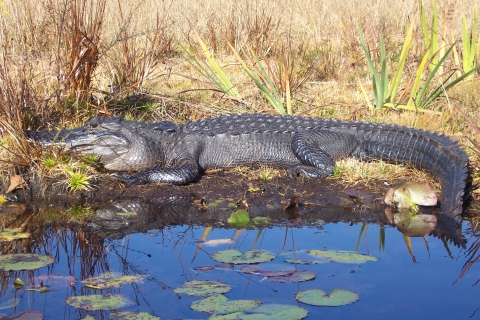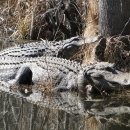About Us
The Okefenokee National Wildlife Refuge was established in 1937 as a "refuge and breeding ground for migratory birds and other wildlife.” The refuge conserves the unique features of the Okefenokee Swamp,the headwaters of the Suwannee and St. Marys rivers. The swamp provides habitat for threatened and endangered species, such as red-cockaded woodpeckers, wood storks, indigo snakes, and a wide variety of other wildlife species. It is world renowned for its amphibian populations that are bio-indicators of global health. More than 600 plant species have been identified on refuge lands.
Today, the refuge is approximately 407,000 acres and is the largest National Wildlife Refuge east of the Mississippi River.
In addition, the refuge is a Wetland of International Importance (RAMSAR Convention – 1971) because it is one of the world’s largest intact freshwater ecosystems. Nearly 359,000 acres of Okefenokee National Wildlife Refuge are assigned as Congressionally-designated wilderness. The legislation that created the Okefenokee National Wildlife Refuge wilderness area wilderness area
Wilderness areas are places untamed by humans. The Wilderness Act of 1964 allows Congress to designate wilderness areas for protection to ensure that America's pristine wild lands will not disappear. Wilderness areas can be part of national wildlife refuges, national parks, national forests or public lands managed by the Bureau of Land Management.
Learn more about wilderness area (353,981 acres) grandfathered in historic uses such as fishing and the use of motorboats up to ten horsepower. It also required the USFWS to maintain four access areas and up to 120 miles of trails. A small number of National Wilderness Areas have additional protection as Class I Air Sheds under the 1990 Clean Air Act. Okefenokee is one of only 21 refuges across the country with this additional designation. Historically, the Okefenokee was the indigenous homeland of the Deptford and Swift Creek Cultures, Weeden Island Culture, Cord-Marked Culture, Timucuan people, and the Seminoles.
Wilderness Area
The Okefenokee Wilderness was designated in 1974 and has a total of 353,981 acres. The Okefenokee Wilderness is managed to restore, preserve, and protect the primeval character and natural processes of the designated lands, leaving it untrammeled by man while providing recreational solitude, education, scientific study, conservation ethics, and scenic vistas.
Okefenokee National Wildlife Refuge and Okefenokee Wilderness encompasses the best-preserved precipitation-based freshwater wetland ecosystem in the conterminous U.S. and the largest in the Northern Hemisphere’s subtropical zone. It is the last-standing large, naturally driven freshwater wetland in the eastern U.S. The resiliency of its diverse habitats from open lakes, marshes, scrub-shrub, cypress and hardwood forests, to pine islands resembling pristine conditions stands out in one of the highly populated and developed temperate/subtropical regions of the world. Designated as a Wilderness Area, management strives to allow ecological processes to govern in order to sustain the ecosystem services it has provided for centuries.
Learn more about the Okefenokee Wilderness
Our Mission
Refuge Vision
The Okefenokee is like no other place on earth, where natural beauty and wilderness prevail. The vision for Okefenokee National Wildlife Refuge is to protect and enhance wildlife and its habitat, ensure integrity of the ecological system, and embrace the grandeur, mystery, and cultural heritage that lead to an enrichment of the human spirit.
Refuge Purpose
Each unit of the National Wildlife Refuge System is established to serve a statutory purpose that targets the conservation of native species dependent on its lands and waters. All activities on those acres are reviewed for compatibility with this statutory purpose. The executive order establishing Okefenokee National Wildlife Refuge in 1937 stated the purposed of the refuge as “a refuge and breeding ground for migratory birds and other wildlife.”
Our History
The establishment of Okefenokee National Wildlife Refuge in 1937 marked the culmination of a movement that had been initiated at least 25 years earlier by a group of scientists from Cornell University who recognized the education, scientific, and recreational values of this unique area. The Okefenokee Society formed in 1918 promoted nationwide interest in the swamp. With the support of state and local interests and numerous conservation and scientific organizations, the Federal Government acquired most of the swamp for refuge purposes in 1936.
According to archeological evidence the swamp was uninhabited until about 2500 BC. Prior to this time, the basin was probably too dry. Evidence indicates that small bands of Native American cultures occupied campsites throughout the swamp through the eighteenth century. Several cultures existed during this period, identified by the types of pottery shards they left behind.
Much of the following was taken from the detailed descriptions of Native American cultures living around the Okefenokee by Chris Trowell in “Indians in the Okefenokee” (1998):
Fiber-tempered Pottery Period (2000 to 1000 BCE) As sea level increased to its present level and "ponds" began to form in the Okefenokee basin, plants and animals began to occupy these new wetland areas. Native Americans from surrounding areas of the coastal plain established seasonal camps around the shores of the Okefenokee and the islands within the swamp. They reinforced their pottery by mixing fibers of grass, moss, or leaves into clay before forming and firing the vessels.
Deptford and Swift Creek Cultures (1000 BCE to 500 CE) Indigenous people seasonally occupied the lush hammocks scattered through and around the swamp. This culture is identified by the designs stamped in their pottery with wooden paddles.
Weeden Island Culture (500 to 1000 CE) At this time, mound-builders from northwest Florida and southwest Georgia settled in the Okefenokee. Their villages were built around burial mounds. These settlements were located in evergreen hammocks of live oak, magnolia and holly trees that had been used by earlier natives. Hunting and collecting continued as a way of life, and eventually villages replaced temporary camps. Weeden Island villages were quite numerous and several of them had a population of several hundred people. Important leaders were buried in the sand burial mounds. Weeden Island pottery is decorated with incised and punctuated designs. Toward the end of the Weeden Island Period, cord-marked pottery, distinctive of coastal Native Americans, began to appear, indicating trade with other tribes or permanent settlements.
Cord Marked Cultures (1000 to 1200 CE) Around 1000 AD Native Americans using cord-marked pottery lived in some of the hammocks and along the swamp’s perimeter. Some, probably most, of these settlers or campers were associated with the Savannah Culture. (At least one small village site is known to be Savannah.) Others were associated with the Alachua Culture from north-central Florida and the Ocmulgee Cord-Marked Culture from south-central Georgia.
1200 to 1700 CE Near the end of the Weeden Island Period, or Cord-Marked Culture, Native American populations declined sharply. Following the Savannah Period, it appears that a few small groups from the Lamar Culture camped, probably seasonally, in some of the previously occupied hammocks. Some of the St. Johns pottery found on Floyds Island, Chesser Island, and other sites may be associated with the Timucuan who occupied an area of northern Florida and southern Georgia during the Spanish period, 1560 to 1700. Spanish documents indicate the presence of a Spanish mission near the swamp's eastern edge. These documents also record attempts to capture and forcibly relocate Native Americans from the mission and other locations within the swamp. The decline of indigenous populations during the 1500s was caused by diseases introduced by colonizers such as smallpox, measles, yellow fever, malaria, influenza, and even the common cold; and by a barbarous slaughter of Timucuan and Apalachee natives by Col. James Moore between 1702 and 1704. It is estimated that between 1500 and 1700 AD these diseases and warfare killed over ninety percent of the Native American population across the American continents.
1750 to 1840 The Seminoles were survivors from different groups including Creeks, Yuchees, and Hitchitis who took refuge in the swamp following skirmishes with European settlers and military forces. The Seminoles settled in a few areas of the Okefenokee between 1750 and 1840, but little archaeological evidence has been found. They used the swamp as a refuge. The Indian Removal Act of 1830 led to the forced removal of Native Americans from the Southeastern U.S. to primarily what is now Oklahoma. The Dade's Massacre in Florida of December 1835 spread violence throughout the area until 1842. Continued skirmishes between the Seminoles and the settlers led to the establishment of several forts around the perimeter of the swamp to protect the settlers. Two forts were built within the swamp, one on The Pocket, another on Billys Island. Federal and state militia attempted to eradicate or remove the Seminoles. Several forts remained occupied and troops continued to patrol the rim of the swamp until 1842.
By 1850, only Native American stories, mounds, scattered ceramic and stone artifacts, and several names on the map remained. Ancient knowledge was lost, and cultures were forever changed as people tried to make new lives and new communities. Native Americans had long-lasting effects on Okefenokee habitats. Fire was used as a hunting tool. Huckleberry, blueberry and chinkapin productivity was enhanced by regular burning of islands. Villages, garden sites, and other areas may have created permanent relict openings. Some of the openings in the swamp may have been caused by fires, both accidentally or intentionally set by Native Americans.
The first settler community in the Okefenokee area was Traders Hill, established on the banks of the St. Marys River in 1755. The Okefenokee area was mapped in the early 1800s as part of Wayne County for disbursement in land lotteries. Colonization of the area occurred slowly because of the apparent worthlessness of the land, difficulty of transportation, and difficulty of protecting the settlements. Most of the original settlers had large families skilled in swamp living. They were highly mobile and usually squatted for a few years on government or unclaimed land and then moved on to a more attractive homestead site. In 1811, Fort Alert was established at Traders Hill. The federal troops left in 1820, but Fort Henderson was established at Traders Hill in 1838. It was occupied until 1842. By 1845, Traders Hill had become a busy river port town and for many years was the Charlton County seat and by 1910, Folkston replaced Traders Hill as the county seat and the area's commercial center.
1850 - 1900 Settler families moved into isolated farmsteads in the Okefenokee area. Most settlers lived in rustic cabins, but a few lived in large, comfortable houses and owned large herds of cattle and hogs. The majority of settlers used fire for hunting and habitat management, a tradition of the Native Americans.
"Their frequent burning of the wire-grass pine woods was probably their greatest legacy,” wrote Trowell and Fussell. “Fire-adapted species of plants, and the creatures that lived in these open woods, became even more dominant. Not only did they burn the upland woods that encircle the swamp, but they burned the islands. This increased visibility for hunting, invigorated the growth of grass for deer, and improved the huckleberry yield. Hunters often set fires on the islands when they left after a hunting trip. Some of the lakes are probably the result of accidentally or intentionally-set fires on tree-houses, especially the prairie lakes near the eastern rim."
In 1857, railroads began to penetrate the swamp, and a new settlement, Waycross, was located at an important trail crossing. By 1881, Waycross was the junction for five railways and by 1890 had a population of 3,000. By the turn of the century, railways circled the swamp, helping to build other cities and villages including Folkston, Fargo, and Homerville. (Hurst 1974).
During the late 1800s industrial operations began to take place that forever changed the face of the Okefenokee.
Other Facilities in this Complex
Okefenokee National Wildlife Refuge is managed as part of the Okefenokee Complex.


